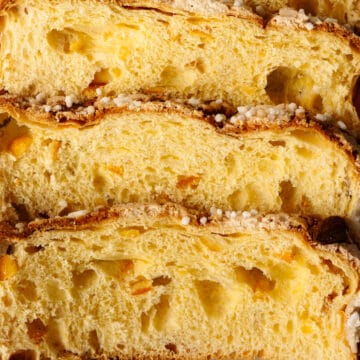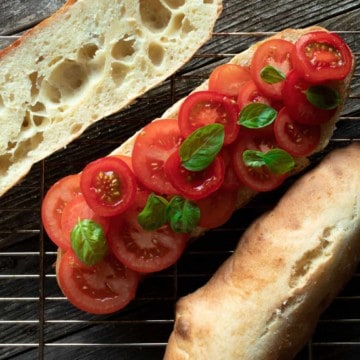
Perhaps you know them from your Italian holidays: crispy friselle, for example with tomatoes and olive oil. The double-baked rolls can be stored for months. An advantage that quickly made the bread from Puglia a favourite all over Italy.
Indispensable friselle
Between the two baking cycles, the friselle are cut in half horizontally. The two parts are also called cocchie. Since they are completely dried by the long baking, they last so long. In Salento in Apulia, they are stored in capàse (clay pots), where they are protected from moisture. Friselle accompany many Italians from breakfast, where they are the perfect substitute for ‘Zwieback”, to sandwiches/snacks between meals, to dinner, for example in fish soup.

Dipping time: one Hail Mary
Before eating, the cocchie are dipped briefly in water. This dipping in water (spunzatura) is repeated three times. Only when this is done correctly do they taste good. If you talk about frisa spunzata in Italy, the bread is too wet and no longer edible. Grandmothers swear that the spunzatura should be exactly one Hail Mary prayer long. But be careful: the dipping time also depends on the piece. The upper cocchia is curved and more irregular. It may only be dipped for a short time. The lower piece is flat and harder. It can be dipped in water for a few seconds longer.
The bread of the Crusaders
The origin of friselle can hardly be traced – they have been known for so long. In the Salento area, they are also referred to as “the bread of the Crusaders”. The need to have non-perishable food for the journey to the Holy Land or even for further journeys made people inventive. In southern Italy, incidentally, the pronunciation of friselle varies from village to village. Thus the rolls become an unmistakable sign of origin and homeland.
📖 Recipe

Friselle, the bread roll for all occasions
Equipment
- 1 bowl
Ingredients
- 250 g durum, ( wheat semolina pasta flour)
- 125 sourdough, refreshed
- 120 ml water
- 5 g salt
Instructions
- Knead all the ingredients for the dough well in a bowl. Cover with a cloth or cling film. Poke air holes in the cling film to allow the dough to breathe. Leave to rise at room temperature for 4-5 hours, or until the dough has doubled in size.
- Now divide the dough into 3 pieces weighing approx. 160 g each. Form approx. 23 cm long rolls from each piece and flatten them slightly. One by one, wrap the dough rolls around four fingers (without thumbs) and connect the ends. Place on a baking tray. The hole in the middle will disappear as the dough continues to rise and bake. Cover the friselle and leave to rise again for 3 hours.
- Pre-heat the oven to 200°C. Bake the friselle for about 15-20 minutes. Cut them horizontally while they are still hot: kitchen yarn is perfect for this. Place all 6 cocchie on the baking tray again with the cut surface facing upwards. Bake at 150°C for another 30 minutes. Leave to cool completely and store in a dry place in a sealable container.
Notes
Nutrition
Ideas for summer friselle
Our favourite way to enjoy friselle is with fresh tomatoes. Cut the tomatoes into large pieces and grate them on the rough surface of the friselle so that the tomato juice runs into the bread. Plenty of extra virgin olive oil, oregano and, if you like, fresh tomatoes complete this masterpiece of simplicity. Less traditional, but equally delicious, are friselle with lampascioni (a typical type of onion from Puglia), olives, tuna and anchovies.
Buon appetito!






Leave a Reply